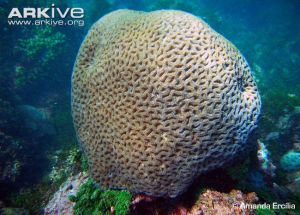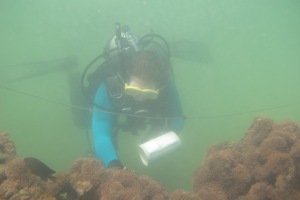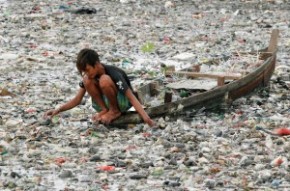I am again lucky to have a great guest blog from a good friend and great scientist, Maarten De Brauwer. Maarten is a tropical marine ecologist who comes from Belgium and now lives in Australia. Maarten works on the extinction risk of reef fishes, ecology/importance of cryptic marine fauna and has a special interest in Indonesia reefs.

Maarten De Brauwer
Anemonefishes, also widely known as clownfishes, have long since been a favorite in the marine aquarium world. These charismatic and beautiful fish and the relationship with their hosts – sea anemones – have fascinated and amused scientists and aquarium enthusiasts for many years. The box office success of the Pixar movie “Finding Nemo” in 2003 made the fish widely known and hugely popular with the general public. Unfortunately, the message of the movie (wild fish should not be kept in tanks) got lost somewhere along the way and the exact opposite happened: an explosive increase in the trade in “Nemo”.

Amphiprion percula “Nemo”
Clownfish as a species are widely known, but besides Nemo’s relationship with its “anemenemone” and its pretty colours, surprisingly little about clownfish biology reached the general public. Amphiprion percula (= scientific slang for “Nemo”) is only one of the 28 species of anemonefishes found globally. The 28 species are found from the Red Sea all the way to French Polynesia in the central Pacific Ocean, leaving the eastern Pacific and Atlantic Ocean devoid of these beautiful creatures. They can be found as far north as southern Japan and almost as far South as Perth, Australia. Many of the species are endemics; occurring only in a very small area. In the clownfishes’ case the endemic species are often found around small oceanic islands such as Seychelles, Mauritius or Chagos Archipelago.
While the adventures of Nemo and his dad in the Pixar movie were positively thrilling, reality in the case of the clownfish far surpasses fiction. The life of an anemonefish is a big adventure, from start to finish, with lots cliff-hangers and unexpected twists in the plot. After baby clownfish hatch from their eggs, they don’t simply move into their parents’ anemone. Instead, they float on the ocean currents for about three weeks, sometimes travelling up to 400km before settling into a suitable anemone. After moving into their new anemone, they transform from a see-through, wormlike larvae into a colourful miniature version of the adult fish. However, every single one these tiny clownfish will be, without exception, male. As a matter of fact, in any social group of clownfish, every individual will be male except for the largest fish. This dominant fish is female and will only mate with the largest male in the anemone.

Amphiprion clarkii with eggs

Amphiprion clarkii eggs
An interesting thing happens when this female dies (say, in the unlikely event she gets eaten by a barracuda), leaving the anemone looking very much like an all-male dorm room in a university, a lot of males wanting to mate, but no female to be found. To solve this problem, the biggest male will change sex, turning into the dominant female, with the next biggest male growing bigger and becoming the breeding male. (I’ll leave the human dorm room-version of this to your imagination) In other words, by the time Nemo’s father actually finds Nemo, it should really have been his mother again…which might have confused children and quite a few parents, but could have made for a very interesting movie in my humble opinion.
Unfortunately, not all is well for the anemonefishes, and the future of some species is could be in serious threat. Over the course of the last year, I collaborated with a great number of outstanding scientists to assess the risk of extinction of all 28 species of anemonefishes. The result of this collaboration is a rather large, global database, which tells us a lot of what’s happening with these fish. A few general conclusions can be made about their extinction risk.
The factor that affects the risk of extinction most strongly, is what gives these fish their name; their obligate relationship with a few species of sea anemones. Anemonefish can only use 10 species of sea anemones, and most species of fish will use only 1 or 2 host species. In the absence of anemones, the fish cannot survive on the reef; reefs without sea anemones will not have any anemonefish. Sea anemones are generally rare on coral reefs, an average of less than 0.2% of the area of coral reefs consists of suitable host anemones. Therefore, living in sea anemones might be safer for the fish which are already inside the anemone, but it makes finding a suitable place to live a lot harder for larval fish.
The quantity of host anemones is already small, but currents trends indicate that it is very likely the quantity will decrease even further in the future. Rising sea temperatures, increased acidification can cause host anemones to bleach and perish. Anemone bleaching is the same mechanism as coral bleaching; single celled algae living in the anemone are expelled, after which the anemone loses colour and is hard pressed to catch enough food to sustain itself. As a result, anemones can shrink, are more susceptible for disease or can die off completely. In recent years, anemone bleaching events have occurred and caused localised disappearance of host anemones and the anemonefish living inside them.
While anemone bleaching might become more frequent in the future, it will rarely occur on a large enough scale to effect the anemonefish species with a wide distribution. The more area a species occupies, the less likely it becomes that the entire area will be affected by bleaching. Which brings us back the many endemic anemonefish species, these are the species that do occupy a small area. In the case of at least three species, it is entirely conceivable that the entire area occupied by the fish is so small, that all of the available host anemones could bleach in one event, potentially removing most of the habitat of the species of anemonefish dependant on it.
A last risk factor, overfishing could also play a role. The popularity of clownfish in the aquarium trade is bigger than ever before, and is likely to increase further with the sequel of “Finding Nemo” planned to be releases in 2016. Overfishing and destructive fishing practices in South-East Asia are known to have caused big declines in clownfish and host anemone populations. While these disturbances are significant on a local scale, they rarely affect the species as a whole. Furthermore, most species of anemonefish can readily be bred in captivity.
So what can we do about these threats? Since the biggest threat, bleaching is hard to remedy, the best we can do at the moment is reduce other stressors (such as overfishing and pollution) by protecting larger areas of coral reef habitat. Bleaching is most often induced by high water temperatures, which are affected by global climate change. So ultimately, the survival of some species of anemonefish, might depend on much bigger challenges, which we can all do small things about, but would take this blog too far away from clownfish.
Finally, try to follow the morale of “Finding Nemo”, don’t keep fish in tanks. And if you do feel the overwhelming need to see Nemo in your own house, make sure it has been bred in captivity and not a poor creature removed from its home anemone on a pristine tropical reef on the other side of the world.

Amphiprion perideraion on the Great Barrier Reef


























